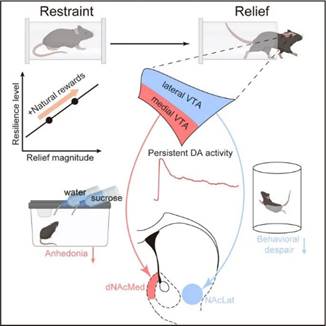Following intense pain or stress, people often experience a sense of relief, akin to the lifting of a heavy burden. But how does this subtle emotion occur?
On September 29, a research paper titled “Stress relief as a natural resilience mechanism against depression-like behaviors” was published in the journal Neuron. In this study, the research team scrutinized the neural pathways in the brain that govern stress relief. They concluded that enhancing stress relief can promote an individual’s resilience against depression. In this light, they proposed a non-invasive, drug-independent behavioral intervention strategy that holds promise for the prevention and management of depression in real-life scenarios.

Graphical Abstract.
In the 1970s, the psychologist R.L. Solomon introduced the “opponent-process theory of motivation,” positing that conflicting emotional experiences drive the formation of new motivational behaviors. For example, addicts endure extreme discomfort during withdrawal after the intense pleasure of drugs eases. Thus, the experience of “pain after pleasure” drives addicts to seek pleasure again.
Over the years, there have been significant strides in research into the “pain after pleasure” phenomenon. In contrast, the mechanism behind stress relief that ensues after the cessation of negative stimuli such as stress, pain, or fear, remains elusive. What transpires in our brain when we experience this sense of relief, and what implications does it hold for individual organisms? Prof. HU Hailan’s research team delved deeply into these intriguing questions.
The initial step in their exploration was to capture the ephemeral sensation of relief in the brain. The research team devised a “room selection” experiment for mice. After confining the mice to a narrow glass tube for several hours, they immediately placed them in one of two rooms designated for “recreation.” Subsequently, the mice were given the freedom to choose which room to enter.
Given that mice were innately active and playful, their confinement was undoubtedly distressing. Did they experience a sense of relief at the close of their confinement? There is a classic behavioral paradigm in animal behavior studies called conditioned place preference (CPP), which assesses the emotional experiences of mice by their preference for spaces associated with pleasant experiences.
Prof. HU Hailan’s research team applied this behavioral paradigm to their experiment design. They discovered that the room where the mice were released after confinement consistently became their preferred choice, as it was directly associated with the positive emotions of stress relief. In contrast, the mice in the control group, which did not go through confinement and release, selected their rooms randomly, without showing any preference. “In this way, we can gauge the intensity of the mice’s relief based on their choice probability and the time spent in the room,” remarked DONG Yiyu.
Although most mice displayed a preference for the room associated with “relief,” the intensity of stress relief varied among them. This opened an avenue for exploring the cause-effect relationship between stress relief and psychological resilience.
The experiments revealed that under the same chronic stress conditions, the mice with a stronger sense of relief were less prone to exhibiting depression-like behaviors. The intensity of “relief” was positively correlated with the level of psychological resilience. Another set of experiments indicated that inhibiting the mice’s ability to experience relief with drugs facilitated the development of depression-like behaviors, while enhancing stress relief effectively thwarted the onset of such behaviors. Hence, the cause-effect relationship between “stress relief and “psychological resilience” was further confirmed.
“We have presented evidence for the physiological function of stress relief” said Prof. HU Hailan. “Stress relief may represent a natural anti-depression mechanism, serving as a psychological buffer that prevents negative emotions from accumulating into psychological trauma.”
How does our brain develop resilience against stress during the course of stress relief? The research team pointed out that the dopamine system in the brain plays a crucial role, for stress relief can continuously activate dopamine neurons in the ventral tegmental area (VTA-DA) for up to 5 minutes.
Moreover, the researchers identified two groups of dopamine neuron subgroups projecting from the VTA to the dorsomedial shell of the nucleus accumbens (dNAcMed) and the lateral shell of the nucleus accumbens (NAcLat) that collectively encode stress relief. VTA-dNAcMed dopamine neurons remained active for up to 9 minutes during the process of stress relief, specifically preventing the loss of pleasure. In contrast, VTA-NAcLat dopamine neurons were briefly activated for 6 seconds, specifically preventing behavioral despair. These findings depicted the neural circuit mechanism underlying the encoding of stress relief.
The brain’s mechanism for inducing stress relief to shape psychological resilience reminds us of Nietzsche’s famous quote: “What does not kill you makes you stronger.” This revelation prompted the research team into pondering how natural depression prevention strategies can be developed based on stress relief. “Providing natural rewards promptly after stress may enhance stress relief and, in turn, boost resilience against depression and prevent depression-like behaviors triggered by chronic stress,” Prof. HU Hailan observed.
In their study, the research team demonstrated the efficacy and superiority of this strategy. When a mouse was provided with natural rewards such as sucrose and chocolate within 2 hours after the termination of aversive stimuli each day, it would be less likely to develop depression-like behaviors. “The hour-level time window is longer than that of the relief window (less than 10 minutes), suggesting that external rewards could extend the time window of internal relief, making this strategy more implementable,” explained DONG Yiyu.
So, in the face of overwhelming stress, remember to “indulge in some sweets”, as this non-invasive, drug-independent behavioral intervention strategy, which proved effective in animal experiments, offers a feasible approach to preventing and managing depressions in humans. “Considering the diversity of entertainment available in the human world, personalized recreational activities promptly after a stressful episode may yield rewarding effects,” Prof. HU Hailan recommended.